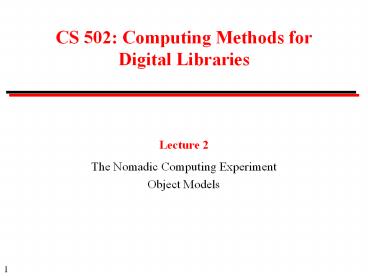CS 502: Computing Methods for Digital Libraries - PowerPoint PPT Presentation
Title:
CS 502: Computing Methods for Digital Libraries
Description:
If we all have this equipment how will it change our computing and work habits? ... Every student taking it for credit is offered a laptop and requested to ... – PowerPoint PPT presentation
Number of Views:26
Avg rating:3.0/5.0
Title: CS 502: Computing Methods for Digital Libraries
1
CS 502 Computing Methods for Digital Libraries
- Lecture 2
- The Nomadic Computing Experiment
- Object Models
2
Administration
- COM 440 and CS 502
- Knowledge of html
3
Nomadic Computing Experiment
Philosophy We are busy people. Better tools
change our work habits. Questions (a) For next
decade, the standard computing environment will
be a laptop with wireless network. If we all have
this equipment how will it change our computing
and work habits? (b) If library access is made
more convenient, will students read more of the
recommended materials? Will they explore new
materials for themselves?
4
Nomadic Computing Experiment
- Research methodology
- CS 502 is an information-intensive course.
- Every student taking it for credit is offered
a laptop and requested to participate in the
experiment. - Short surveys about how you use computing.
- Connect browsers through a proxy that monitors
the URLs that you access. - Basic research questions
- Which of the recommended readings do you read?
- When do you prepare for class?
- What else do you read?
5
URL Resolution
WWW browser
URL
HTTP server
Resource
6
Proxy Resolution
Resource
WWW browser
Proxy server
Log database
URL
Resource
URL
HTTP server
7
Proxy Resolution via Browser
The laptop has two browsers installed
Internet Explorer v.5 with changeable proxy
settings Netscape Navigator with
changeable proxy settings See the instructions
for changing the proxy settings. Please use the
proxy for all course- related work.
8
Nomadic Computing Experiment
- Privacy
- Taking part in the research is optional in CS
502. - No information gathered by the study will be
used for grading or assessment. - All research results will be reported in a
way that conceals the identity of individual
students. - The research program has been approved by
the University Committee on Human Subjects. - When you pick up your laptop, you will be
required to sign - http//www.cs.cornell.edu/cs502-sp00/consent.
html
9
The Wireless Network
10
The Nomadic Equipment
The Laptop Computers Information about the
equipment, the network, policies and
procedures http//www.nomad.cornell.edu/techsupp
ort/ Human help raj_at_cs.cornell.edu Thanks
to Intel Academic donation program Dean
Eckstrom and others at CS CIT for network
installation
11
Points to Note
- The computers are university property. There
will be a 50 charge for lost or damage. - In you withdraw from the course, you must
return the computer promptly to Upson 311. - Remove the Aironet card when carrying the
computer in its case. Power off before removing
or inserting the card. - You are responsible for back-up. For security,
we recommend that you save your personal files on
the D drive.
12
Collecting your Laptop
- Read and understand the online instructions
- Pick-up is from 311 Upson Hall
- January 27th, 130 to 430
- February 1st, 800 to 1100 AM
- February 3rd, 130 to 430 PM
- Bring your Campus ID
- Sign consent form
- Choose either an Ethernet card or a modem card
- Change password to the Nomad server
13
Object Models
14
General Architecture
User interface
Repositories
Search services
Identification services
15
Object Models
- Digital object An item as stored in a digital
library, consisting of data, metadata, and an
identifier. - Object model The relationship between digital
objects and the content that they represent.
16
Stored Forms and Presentations
- The stored form of a digital object and
presentation to user are usually different, e.g., - Web page is stored as HTML source, which is
rendered by a browser for presentation. - Flight simulation is stored as collection of
programs, data files, etc, but presented to the
user as a virtual environment. - A digital object may have many presentations,
e.g., - An image has a thumbnail presentation and a
high-resolution presentation.
17
Techniques used Object Models
Identifiers for digital objects and the component
parts of digital objects Data types which specify
what the data represents Structural metadata
which represent the relationship between related
digital objects and their component
parts Reference links which show relationships
between digital objects
18
Object Model for a Web Page
Identifier http//www.lycos.com/ Data
type text/html Structural metadata
none - flat file Reference links
underlined in blue
19
Object ModelSet of Digitized Page Images
Data Each page separate image may have
several representations Metadata Structure of
work page sequence page numbers special
pages
20
Data Structure
Identifier
loc.ndlp/amrlp.13579
Data
page 1 gif
page 3 gif
page 2 gif
doc1 page map
Metadata
21
Object Model for Set of Scanned Page Images
Identifier Handle Data types Each page is
image/jpeg (MIME type) The digital object is
doc1 (structural type) Structural metadata Page
map Reference links none
22
Data Types
Data type Structural metadata associated with
digital data that indicates the digital format or
the application used to process the data. MIME
type A scheme for specifying the data type of
digital material. Used in electronic mail and
the web. Examples text/plain image/tiff video
/mpeg application/pdf
23
Structural Types
Genre Describes category of content,
e.g., jazz, blues, rap, rock, ... painting,
fresco, mural, ... operating system, compiler,
interpreter, ... Structural type Describes
structure of computer representation,
e.g., scanned image web page marked-up
text digitized audio
24
Readings for Wednesday
On the CS 502 web site, see the page "Readings
and References."
Read the references for the Week 2 Discussion
Class. Be prepared to discuss a) What are the
differences between URLs and Uniform Resources
Names? b) What are the advantages and
disadvantages of the approaches followed by the
Handle (DOI) and PURL approaches?

